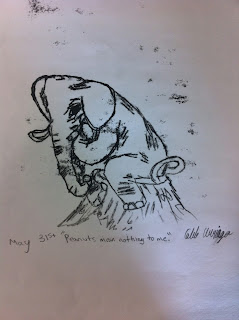Once upon a time, I was planning to teach silkscreening, but I had never done it myself. Armed with some google search results and supplies I brought home and spread out on the kitchen table, this problem was quickly remedied. Days later, I was able to teach several high school classes how to silkscreen some simple stenciled images onto paper using the following supplies & steps:
Supplies:
- Screen Printing Units (2-4)
- Water Soluble Block Printing Ink
- Graphic Squeegees
- X-acto knives & cutting pads (or cardboard scraps work too)
- Freezer paper
- Basic Colored Copy Paper (can always be found in your trusty teacher workroom)
- Masking Tape
- Newspaper
Steps:
- Introduce Students To Printmaking/Focus on a Theme for Silk Screens. See Part I in this printmaking post series for my thoughts on introducing students to the many ways to make a print when teaching just one type of printmaking...Unlike trace monotype, it is important to pick a theme when teaching a more complicated printmaking process like silkscreening in order to avoid students spending too much time worrying about the what only to become overwhelmed when approaching the how. Pop Art and the concept of repetition made famous by Andy Warhol is a decidedly easy fall back. Not to mention, students hop on board the Pop Art Train pretty readily since practically everything they care about falls into the category of pop art imagery--iphones & other technology, sports logos & other logos, movie stars, musicians, fashion, cupcakes, you name it--it's pop art! Also, printing on paper instead of fabric is affordable and saves a lot of grief if mistakes are made during the screen printing process. Make sure you are using water soluble ink for paper.
- Teach students how to make a stencil. That last statement is much easier said than done. If you have some fail-proof way of explaining the art of converting your favorite drawn image to a successful stencil, I'd love to hear it. The main concept you want to convey to students is that lines/shapes that touch will translate to a blob that will be cut out and filled in with ink later. The best rule of thumb is to pick out the main shapes that define value in a drawing and stick to those. Many students will catch your drift immediately, but you'll be left with a handful of head-scratchers who continue to produce drawings that just won't work as a stencil. Sometimes the only way to get through to these stubborn kiddos (because they usually are pretty stubborn and will likely become annoyed with you when you stand over them for the 5th or 6th time saying "Nope, not gonna work..."), is to just let them try to start cutting their doomed sketch into a stencil and hope the light bulb clicks on when they end up with a big void where they meant to have several snazzy details. One way I ended up getting through to a few students like this once was to draw a jack-o-lantern on the board. Pretty much everyone has cut a pumpkin at Halloween once in their lives, and this may help them catch your drift quickly. Having a precursor lesson about implied line is another great lead-in to teaching stencil making. Also, always remember to remind students that they will end up with the reverse image of their drawing when completing a screen print, so logos and words always need to be drawn/cut backwards. Making a one-layer screen print is the easiest, but many students may want to go a step or two further and layer 2-3 value stencils together to make a more complex print.
Here is a stencil made on wax paper (freezer paper works better though!) from a quick self-portrait sketch I completed by blocking out & drawing all of main dark value shapes in a photograph of myself.
- Start Printing 2-4 Students at a Time at Printmaking Station. Silkscreening is a delicate process, especially if a student is layering 2-3 value stencils. The registration has to be exact or the student will be devastated when value lines don't line up, and you will feel responsible. Demonstrate how to place tape at the corner of the paper line on the wooden board backing of the screen print unit to ensure that each piece of paper is laid in the appropriate place. More tape is needed to keep the freezer paper stencil registered properly beneath the mesh silk screen. Once paper & stencil are in place, close the screen printing unit and apply ink as needed to the top of the silk screen. Squeegee the ink in a fluid motion from top to bottom. Remove the print to dry on a drying rack when finished. The screen frame of the printing unit will need to be detached, cleaned and dried thoroughly after each use. Allow at least 5-10 minutes of clean up at the end of each class, and as always, elect trusted students to assist you with helping other students to print and clean up around the printmaking station. Once students have completed a satisfactory series of 3-4 prints, they can be mounted on posterboard for a lovely Warhol-esque result to display in your school hallways or display cases!
My completed print from the aforementioned self-taught lesson at my kitchen table.Students at printmaking station.
Completed Student Prints Ready for Display!
*Even cheaper Silkscreening On a Dime Footnote!
Did you know you can silkscreen using Modge Podge, cheap craft store picture frames & pretty much any type of sheer fabric?! Learn how here! (I did this to make t-shirts with art club students last year, but I failed to take photos of any of the process.)
















